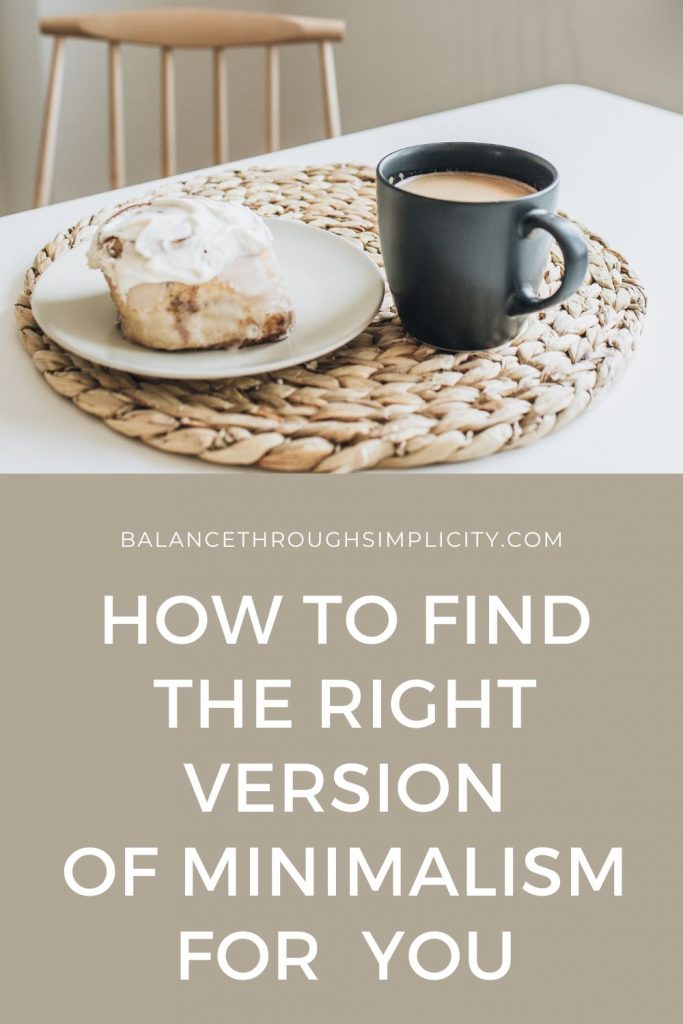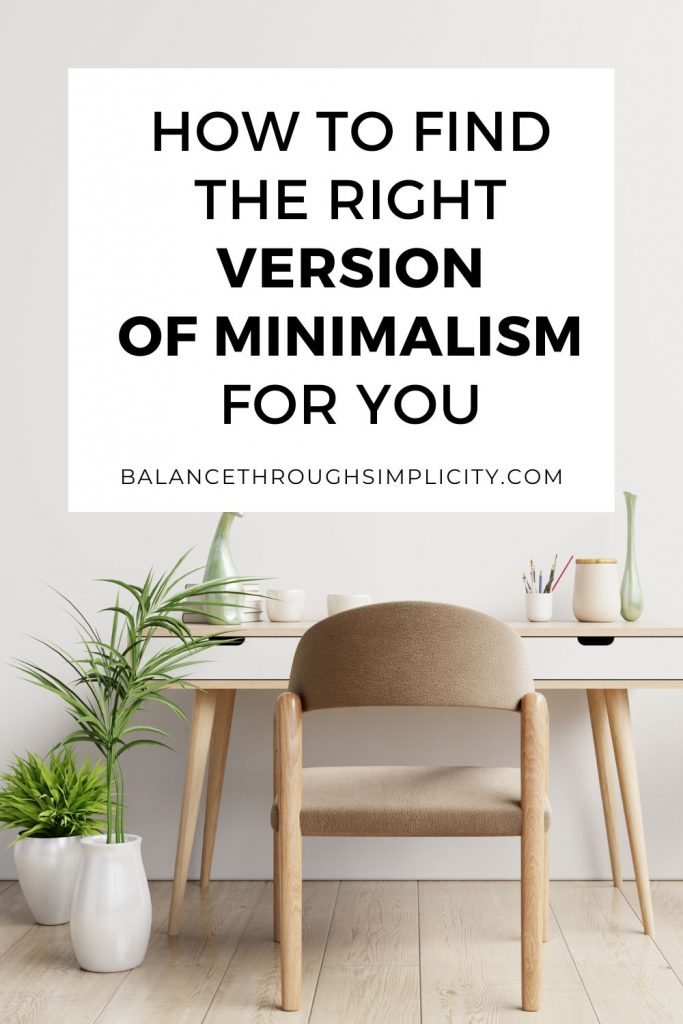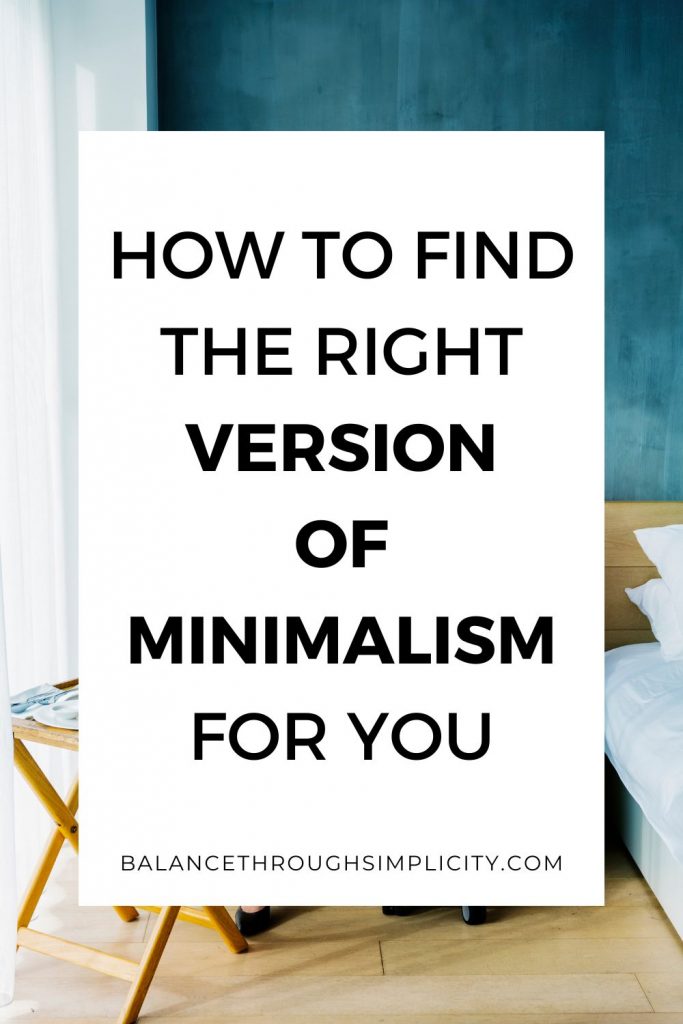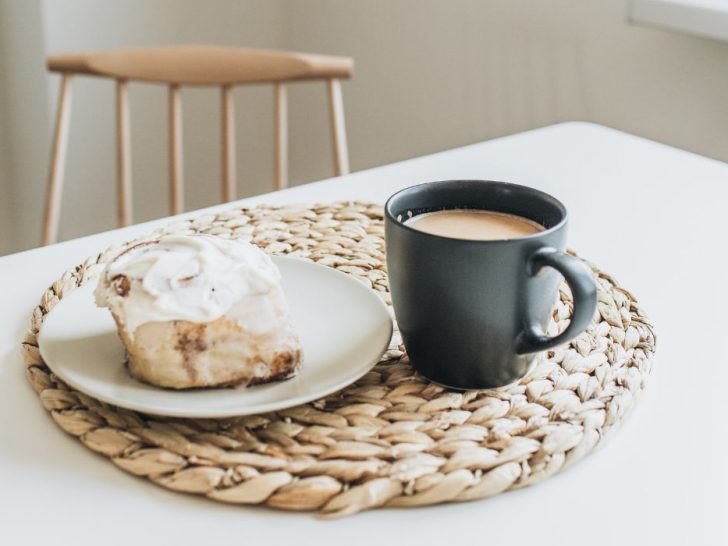HOW TO FIND THE RIGHT VERSION OF MINIMALISM FOR YOU
Looking for a way to simplify your life and curious about whether the minimalist lifestyle would work for you? Here are some thoughts about minimalism and tips on how to find the right version of minimalism for you.
HOW TO FIND THE RIGHT VERSION OF MINIMALISM FOR YOU
I’m so glad you’re reading this article! I hope it helps break down some of the myths of minimalism and makes it more accessible and understandable if you’re just starting your own simplicity journey.
I believe that minimalism is warm-hearted and compassionate, not cold and bland as often perceived. Nonetheless, I really do think it’s important to find the right version of minimalism for you. One that feels right in both your heart and mind.
In this article I hope to share some thoughts about the minimalist lifestyle, tips on how to find the right version of minimalism for you and some quick little action steps you can take to make minimalism in real life work for you right now!
MY UNPLANNED BUT INTERESTING EXPERIMENT IN MINIMALISM!
As I write this, we’re getting ready to move house. Although we won’t be moving for a while, my husband and I decided we wanted to make our move as easy and stress-free as possible. To avoid the last minute rush to sort and pack our stuff, we decided to declutter before moving, well in advance of our moving date.
This means we donated our unwanted furniture and have packed stuff away that we want to take with us but that we won’t be needing over the coming weeks, although we can still get to everything if we need to.
As we’ve condensed our belongings, we now have one room that’s pretty empty. One of my step-sons uses it as a bedroom when he stays with us, but apart from a chair that opens out into a bed, a side table and a floor-standing lamp, the room is empty.
There’s nothing hanging on the walls, displayed on shelves, resting on table tops. There are no cushions, rugs or little ornaments.
This room is amazingly easy to keep clean and tidy as there’s nothing in it to move, tidy or clear away. That’s one of the wonderful benefits of a decluttered home!
It also feels very peaceful, calm, spacious and, as a bedroom, a lovely distraction-free zone to head off to sleep.
All in all, the room is minimalist.
Action step: What does the term ‘minimalism’ mean to you as a lifestyle? Journal your thoughts and see what comes through.
POPULAR BELIEFS ABOUT MINIMALISM
We often think of minimalist homes as clear and clutter-free. Neutral colour palettes, everything neat, tidy and organised. Clean lines, maybe modern silouhettes, strategic lighting and nothing out of place.
The bedroom I’ve been describing fits this minimalist description perfectly.
But, here’s the thing…
I don’t like the room this way. It certainly has some good points, but I also feel it lacks character, expression, emotion and warmth.
Action point: Would you describe your home, or any part of your home, as minimalist? If yes, why? If not, why?

THE DIFFERENT DEGREES OF MINIMALISM
I’m a minimalist. I live minimally, I write about minimalism and even encourage others to try minimalism for themselves and offer tips and resources on how to get started.
But how do I reconcile myself with not liking this minimalist bedroom with my passion for all things minimalist? Perhaps I’m trying to be (or convincing myself to be) something I’m not?
In actual fact, I think it’s just that I prefer to do minimalism in my home another way. I like colour, art on the walls, a cozy and warm atmosphere. Everything adds value and enhances my home, and it’s still quick and easy enough to clean, but my home certainly isn’t completely minimalist. I’ve found my own version of minimalism that works for me and my family.
My accidentally super-minimalist spare bedroom has provided me with an interesting lesson and a reminder that I wanted to share with you today.
Minimalism isn’t this or that. It’s not just one thing or the other, this way or no way. Minimalism is a spectrum and how you choose the right version of minimalism is up to you.
Action point: Where do you think you fall on the minimalist spectrum? Is it a comfortable place for you to be? Does it feel right for your home and your family right now?
THE DEFINITION OF MINIMALISM
Minimalism is a lifestyle that encourages us to be mindful and intentional about what we keep in our lives and what we keep out.
For many people, that means most obviously our stuff. Too much clutter means too much stuff we have to look after and manage. Not only does this drain our time, energy, money, freedom and other precious resources but it takes us away from the rest of what life has to offer – the meaningful and important.
As a very simple example, I’d rather be heading off out for a day with my family than doing the housework. I’d rather spend money on an activity for my kids at the weekend than on another pair of shoes sitting in my closet.
These may be little examples but you get the idea. A minimalist life encourages us to be purposeful and aware of we do and don’t do. Instead of just doing the same things over and over, minimalism makes us question what’s really important and honour that every day, not just what our To Do list says is most important.
Action point: How would you define ‘minimalism’?
Minimalism is the intentional promotion of the things we most value and the removal of anything that distracts us from it.
Joshua Becker
THE MINIMALIST LIFESTYLE
Even though minimalism often goes hand in hand with decluttering, minimalism is not just about your stuff. Clearing clutter is an important part of the minimalist lifestyle and usually where people start, but it’s not the definition of minimalism.
Decluttering is the tool, minimalism is the lifestyle. There’s a subtle but important difference. To put it another way, it’s possible to declutter without becoming minimalist, but it’s not possible to become minimalist without decluttering.
Minimalism is a lifestyle about intention. You could probably even swap the word ‘minimalism’ for intention, or prioritisation, because that’s what minimalists do. They get clear on what’s important, what’s a priority in life and make space for it every day.
Your priorities could be your family, your work, your finances, your health, your relationships, your mental health. Priorities shift and you might even have 2 or 3 that run alongside each other, if not more.
Knowing your priorities and, importantly, keeping them front and centre when you make decisions, is key to a minimalist life.
As an example, you might sometimes say no to an invite if you’re feeling overwhelmed and stressed out and your body and brain need to rest. You might forego that new top you saw in the shop window if you’d rather have money in your bank account than yet another beautiful piece of clothing that’s just sitting unworn at the back of your closet.
An intentional, minimalist life encourages us to make decisions about what’s important enough to keep in and let go.
Action point: What are your current priorities? What’s most important to you in this season of life. (No judgement, no expectation, just be honest with yourself). Try this free Know Your Priorities worksheet to help guide you.

THE TRADE-OFFS OF MINIMALISM
With these decisions there comes an inherent trade-off. You can’t accept the invite and have the free time, buy the top but still have that money in the bank. Whichever choice you make, you naturally forego the other. This is the trade-off.
Minimalism is about getting comfortable with making these decisions and accepting the trade-offs because you know, ultimately, that the decision you make is the right one for your life, your priorities and the resources you have available to you.
Most of us want more time, more money, more freedom, more love, more laughter… more of everything really. But to have more of these things, we also often end up having less of others.
A busy, full on life comes at a cost. It’s often expensive to maintain, exhausting to keep up with and doesn’t leave us much space or wiggle room for ourselves or managing the inevitable hard times that come with general life.
Instead, a minimalist will be intentional about what they have more and less of, what they keep in and what they keep out and the trade-offs that follow as a result.
Action point: What’s your lifestyle like right now. What are your current biggest trade-offs? Time, money, something else? If you’d like to re-assess your life, why not try my free training to help you look at life from a fresh perspective. This is Your Intentional Life!
THE MINIMALIST MINDSET
This last sentence is how a minimalist mindset works. You’ll notice that I haven’t even mentioned stuff or clutter in that description because minimalism isn’t really about your stuff at all. It’s about your mindset, what the inner you is really wanting out of life behind all the shiny blingy things that capture our attention on the surface.
Going back to my emptyish bedroom and the topic of this article, how to find the right version of minimalism for you, I like to think that minimalism doesn’t really care what your home or life looks like, it’s how it feels to you that counts.
As we’re all unique and different when it comes to how we feel about things, there’s no right or wrong.
There are many minimalists who live in tiny homes, count the number of items in their wardrobes, get rid of furniture or travel the world with all their possessions in a backpack. These sound exciting, fun and challenging in different ways!
There are also many minimalists who love their vintage record collection, are proud of the galleries of artwork on their walls, have too many pots and pans in their kitchen cupboard, who haven’t yet gotten around to sorting through their old photos. This sounds a bit more flexible and realistic for many of us, but it doesn’t mean it’s not minimalist. It just means we’re not perfect, perhaps we’re a work in progress, or other priorities are more important.
Personally, I believe that how minimalism looks on the outside is personal preference. It’s what minimalism looks on the inside that counts.
Action point: How do you really feel about your life right now? What are you really happy with? What would you like to change?
MINIMALISM IS NOT ABOUT YOUR STUFF
And so how do you find the right version of minimalism for you?
In this article I wanted to set the scene for minimalism. I don’t know if you’re new to the concept and curious or you’re familiar with it and love it or loathe it!
However, I do think that one of the reasons why minimalism puts some people off is that they feel there’s a minimalist stereotype. It’s probably somebody who would love the look and feel of my spartan spare bedroom!
But I do really believe that’s doing minimalism a dis-service.
I’ve mentioned that minimalism is about intention, it’s about trade-offs and prioritisation. It’s not about your stuff, it’s about how you think about your home and life and how it feels, not what it looks like.
Of course, minimalism is about decluttering and owning less stuff, but minimalism is also a spectrum, from extreme to mild and it plays out in different ways. You can have a beautifully curated minimalist home, or a family-friendly colourful and lively home – but still minimalist. You could have no artwork or lots of artwork, all white walls or patchwork walls, a daily uniform you feel comfortable in or an eclectic wardrobe that makes you stand out in a crowd!
It doesn’t matter how minimalism plays out in your life, what matters is that you are mindful, intentional, aware and proactive about the types of clutter in your life and you keep these things out as much as possible, every day.
Action point: What clutters your life right now? Need to get rid of a few things? Try this handy decluttering checklist!

HOW TO FIND THE RIGHT VERSION OF MINIMALISM FOR YOU
That’s the first step to finding the right version of minimalism for you. Knowing that you can tread your own path and create a minimalist life that feels right to you.
The second step is working out what’s important to you so you can take intentional steps to prioritise this.
Here are some ways you can do this:
- Reflect on these journal prompts for decluttering your home and life
- Understand your priorities and get clear on what matters most to you
- Stop the cycle of clutter entering your home and life
- Get a feel for what minimalism is and a few things it’s not
- Try these 7 easy ways to get started with minimalism
WHEN MINIMALISM DOESN’T FEEL RIGHT TO YOU
I love the benefits of minimalism and I feel those benefits every day. However, I also feel it’s important to say that minimalism isn’t the only way.
When busy life comes hurtling towards us, it’s tough to make changes, face up to things that aren’t working, backtrack on decisions that got us to where we are now and be truthful to ourselves about how we feel.
All of these things require energy, motivation, courage and discipline and we don’t always have these resources to call upon. Sometimes it’s difficult enough just getting out of bed.
If minimalism isn’t your jam, or you feel it’s not something you can or would like to explore, then that’s fine. There are many ways you can simplify your life in small, baby steps… if you want to.
There’s no judgement, no right or wrong, no one way is better than another. Give yourself time, space and an open mind and heart to just explore how to make life better and more meaningful if you’d like to and just when you’re ready.
MAKING MINIMALISM WORK FOR YOU
What happens if you don’t find the right version of minimalism for you? I’d hazard a guess that you might make a few changes but then get demoralised and give up. It might feel a little like trying to fit a square peg into a round hole and wondering why it feels so difficult!
Minimalism is a liberating and empowering lifestyle that can take your life from feeling overwhelming and overstuffed to joyful, at ease and meaningful.
That’s not to say that the transition is easy, no way! Simplifying life isn’t easy. You’re often changing habits, thought patterns, behaviours, not to mention emotions and clutter that you’ve been carrying around with you for years. You may also not have much support, time, energy or knowledge about where to start, what to do, let alone how to do it!
Minimalism may not be easy but I hope this article has at least given you confidence and permission if you needed it, to find your own way to a minimalist life. A life that feels and looks how you want it to but that’s based on the fundamental principle of minimalism – keep what adds value in some way and let go of the rest.
Make space to create a life you love… whatever that looks and feels like to you.
Action point: What are your biggest obstacles to a minimalist life? How can you take your first steps to overcome them?
SHARE YOUR THOUGHTS
I’d love to know how you feel about minimalism? Does it feel stark and bland or have you found a way to bring joy, warmth and meaning into your minimalist life? What’s been your biggest struggle or misconception about minimalism? Have your views about minimalism changed over time? Leave a comment as I’d love to hear from you!
YOUR NEXT STEP…
If you enjoyed this article, I invite you to take your next step.
My Declutter Starter Kit will help you clear clutter from not just your home, but your schedule, heart and mind as well.
Pop your details in the box below to get your copy…
And if you’re ready for real change, take a look at Simplify Your Life. This is a guided simplicity workbook to help you work out what a minimalist, simple and intentional life could look like for you! Click here to learn more.
DON’T MISS OUT!
I’m Antonia and on this blog I share practical inspiration to simplify your home, time and life. Follow me on Instagram, Facebook and Pinterest! You can also subscribe to Balance Through Simplicity and receive regular simplicity tips straight to your inbox for free. Make sure you never miss an article plus you’ll get a copy of my free Declutter Starter Kit as a welcome gift!

